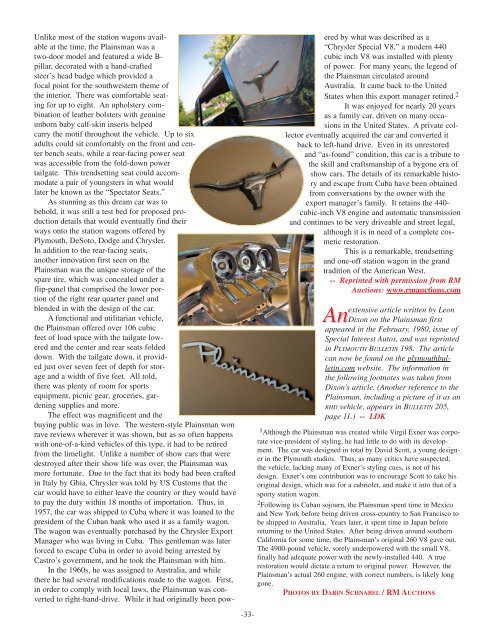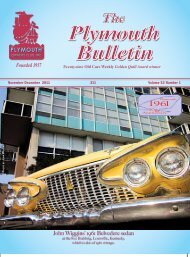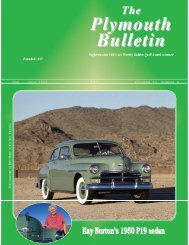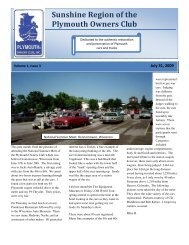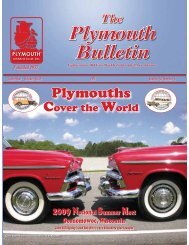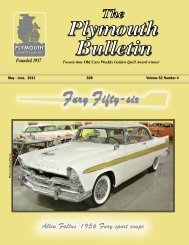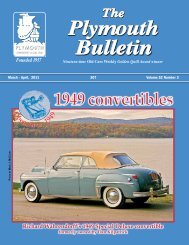PB 300 new page 15-16-17.indd - Plymouth Club
PB 300 new page 15-16-17.indd - Plymouth Club
PB 300 new page 15-16-17.indd - Plymouth Club
Create successful ePaper yourself
Turn your PDF publications into a flip-book with our unique Google optimized e-Paper software.
Unlike most of the station wagons available<br />
at the time, the Plainsman was a<br />
two-door model and featured a wide Bpillar,<br />
decorated with a hand-crafted<br />
steer’s head badge which provided a<br />
focal point for the southwestern theme of<br />
the interior. There was comfortable seating<br />
for up to eight. An upholstery combination<br />
of leather bolsters with genuine<br />
unborn baby calf-skin inserts helped<br />
carry the motif throughout the vehicle. Up to six<br />
adults could sit comfortably on the front and center<br />
bench seats, while a rear-facing power seat<br />
was accessible from the fold-down power<br />
tailgate. This trendsetting seat could accommodate<br />
a pair of youngsters in what would<br />
later be known as the “Spectator Seats.”<br />
As stunning as this dream car was to<br />
behold, it was still a test bed for proposed production<br />
details that would eventually find their<br />
ways onto the station wagons offered by<br />
<strong>Plymouth</strong>, DeSoto, Dodge and Chrysler.<br />
In addition to the rear-facing seats,<br />
another innovation first seen on the<br />
Plainsman was the unique storage of the<br />
spare tire, which was concealed under a<br />
flip-panel that comprised the lower portion<br />
of the right rear quarter panel and<br />
blended in with the design of the car.<br />
A functional and utilitarian vehicle,<br />
the Plainsman offered over 106 cubic<br />
feet of load space with the tailgate lowered<br />
and the center and rear seats folded<br />
down. With the tailgate down, it provided<br />
just over seven feet of depth for storage<br />
and a width of five feet. All told,<br />
there was plenty of room for sports<br />
equipment, picnic gear, groceries, gardening<br />
supplies and more.<br />
The effect was magnificent and the<br />
buying public was in love. The western-style Plainsman won<br />
rave reviews wherever it was shown, but as so often happens<br />
with one-of-a-kind vehicles of this type, it had to be retired<br />
from the limelight. Unlike a number of show cars that were<br />
destroyed after their show life was over, the Plainsman was<br />
more fortunate. Due to the fact that its body had been crafted<br />
in Italy by Ghia, Chrysler was told by US Customs that the<br />
car would have to either leave the country or they would have<br />
to pay the duty within 18 months of importation. Thus, in<br />
1957, the car was shipped to Cuba where it was loaned to the<br />
president of the Cuban bank who used it as a family wagon.<br />
The wagon was eventually purchased by the Chrysler Export<br />
Manager who was living in Cuba. This gentleman was later<br />
forced to escape Cuba in order to avoid being arrested by<br />
Castro’s government, and he took the Plainsman with him.<br />
In the 1960s, he was assigned to Australia, and while<br />
there he had several modifications made to the wagon. First,<br />
in order to comply with local laws, the Plainsman was converted<br />
to right-hand-drive. While it had originally been pow-<br />
-33-<br />
ered by what was described as a<br />
“Chrysler Special V8,” a modern 440<br />
cubic inch V8 was installed with plenty<br />
of power. For many years, the legend of<br />
the Plainsman circulated around<br />
Australia. It came back to the United<br />
States when this export manager retired. 2<br />
It was enjoyed for nearly 20 years<br />
as a family car, driven on many occasions<br />
in the United States. A private collector<br />
eventually acquired the car and converted it<br />
back to left-hand drive. Even in its unrestored<br />
and “as-found” condition, this car is a tribute to<br />
the skill and craftsmanship of a bygone era of<br />
show cars. The details of its remarkable history<br />
and escape from Cuba have been obtained<br />
from conversations by the owner with the<br />
export manager’s family. It retains the 440cubic-inch<br />
V8 engine and automatic transmission<br />
and continues to be very driveable and street legal,<br />
although it is in need of a complete cosmetic<br />
restoration.<br />
This is a remarkable, trendsetting<br />
and one-off station wagon in the grand<br />
tradition of the American West.<br />
-- Reprinted with permission from RM<br />
Auctions: www.rmauctions.com<br />
extensive article written by Leon<br />
An Dixon on the Plainsman first<br />
appeared in the February, 1980, issue of<br />
Special Interest Autos, and was reprinted<br />
in PLYMOUTH BULLETIN 198. The article<br />
can now be found on the plymouthbulletin.com<br />
website. The information in<br />
the following footnotes was taken from<br />
Dixon’s article. (Another reference to the<br />
Plainsman, including a picture of it as an<br />
RHD vehicle, appears in BULLETIN 205,<br />
<strong>page</strong> 11.) -- LDK<br />
1Although the Plainsman was created while Virgil Exner was corporate<br />
vice-president of styling, he had little to do with its development.<br />
The car was designed in total by David Scott, a young designer<br />
in the <strong>Plymouth</strong> studios. Thus, as many critics have suspected,<br />
the vehicle, lacking many of Exner’s styling cues, is not of his<br />
design. Exner’s one contribution was to encourage Scott to take his<br />
original design, which was for a cabriolet, and make it into that of a<br />
sporty station wagon.<br />
2Following its Cuban sojourn, the Plainsman spent time in Mexico<br />
and New York before being driven cross-country to San Francisco to<br />
be shipped to Australia. Years later, it spent time in Japan before<br />
returning to the United States. After being driven around southern<br />
California for some time, the Plainsman’s original 260 V8 gave out.<br />
The 4900-pound vehicle, sorely underpowered with the small V8,<br />
finally had adequate power with the <strong>new</strong>ly-installed 440. A true<br />
restoration would dictate a return to original power. However, the<br />
Plainsman’s actual 260 engine, with correct numbers, is likely long<br />
gone.<br />
PHOTOS BY DARIN SCHNABEL / RM AUCTIONS


